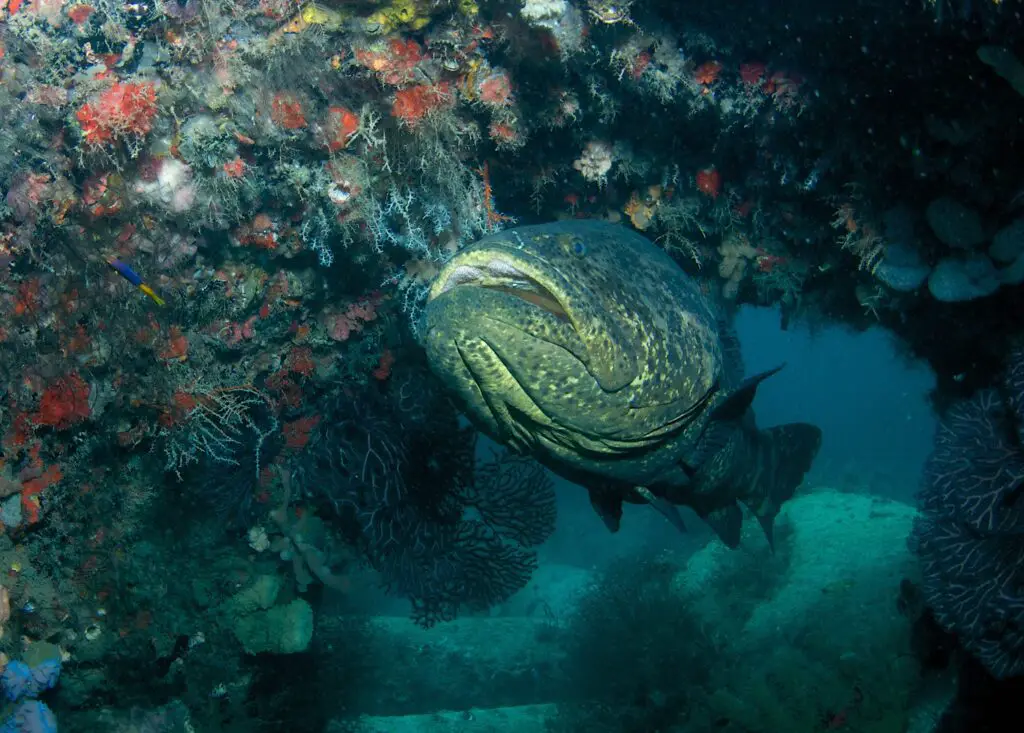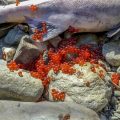There are many species of grouper fish, and some are more common than others. The grouper fish that are protected are not widely available in the wild. One protected grouper is the Goliath grouper, which is protected due to the fish being endangered.
The Goliath grouper is a protected species for several reasons. Being a protected species means that it is not abundant in the wild and only a few of these fish are available, so they should not be killed. Goliath groupers are one of the most well-known grouper species due to their massive size and controversy regarding the protection they get.
Groupers can get around 8 feet long and weigh 800 pounds, making them one of the larger fish found in the ocean. Anglers think it is a huge honor if they can spot one of these fishes. This is an endangered species because it has a slow growth rate and reproduces rarely. The fish can live for hundreds of years, and it is first born as a female and then turns into a male fish.
According to the World Conservation Union (IUCN), this species of grouper is listed as “critically endangered.” As a result, it has been banned to fish for this species in the US since 1990 and in the Caribbean since 1993. Since it is such a large fish, it takes a long time for it to reach sexual maturity, which means it takes a long time for it to reproduce after being born.

Will Goliath Grouper Always Be Protected?
Recently, in 2021 the ban on harvesting this fish was in talks to be removed. This is a fish that has been protected for a while, but finally, it might not be protected anymore. This means people can hunt, catch, harvest, eat, and do much more with the Goliath grouper. Once the ban is lifted, the fish will be used for commercial purposes, as well as recreational sport fishing. People will be able to catch the fish via a goliath grouper harvest permit and tag that would be issued via a random-draw lottery. As a result, one person will be allowed to catch one Goliath grouper per season, and it cannot be too large.
Some people are against the lifting of this ban, but some are in favor. People are against the lifting of this ban because Goliath groupers are still an endangered species, and their numbers are dwindling. On the other side, once there is a Goliath grouper in the water, it feeds on a lot of fish, crustaceans, and much more, which causes the number of other ocean inhabitants to dwindle. It might take a while to decide whether Goliath grouper should be protected or not.
How Many Grouper Species Are Protected?
Out of the hundreds of grouper species in the wild, almost 20 are listed as being endangered or close to being endangered. Of course, the Goliath grouper is one of the biggest fish on that list. Except for the giant fish, some other protected grouper species exist.
Speckled Hind
The speckled hind grouper is also known as the strawberry grouper and is found in Bermuda and along the eastern coast of North America. This species of grouper is critically endangered and cannot be found in most places. This grouper is a unique species that, unlike most other groupers, is brightly colored, often yellow, with white dots all over its body.
Since the fish is critically endangered, people can only fish for one of them per vessel, and then it should be returned to the ocean. However, there is still overfishing of this fish, and the fish that is returned to the ocean is often injured and dies anyway.
Warsaw grouper
Warsaw grouper or Hyporthodus nigritus is another huge grouper that often gets confused with Goliath grouper because it has an unassuming body. This endangered grouper species might go extinct if more care is not provided. It is found in the Western Atlantic, inhibiting the deep sea just like Goliath, which also makes spotting this fish difficult. The fish can exceed 8 feet in length as well.
Hong Kong Grouper
The Hong Kong grouper is found in eastern and southeastern Asia in shallow seas and coral reefs. This fish is labeled as endangered. Hong Kong grouper is another species of grouper that is unique in its appearance with its colorful body. This is a relatively small fish, which is around 12 inches in length in the wild. This fish species is very popular in Hong Kong and Japan, as it is considered a highly valued fish, but still, fishing for this fish goes unregulated in these countries.
Dusky Grouper
The dusky grouper is a vulnerable species in the Mediterranean Sea and along the North African coast. This is a typically large, round-bodied fish found in deep waters. When compared to adult fish, juvenile fish prefer shallow water. This fish is a victim of overfishing, as it is seen as a delicacy in some countries or caught by spearfishing or anglers. Dusky grouper is slow in growth and reproduction, so overfishing causes the sex ratio of the fish to mess up, thus decreasing their number and chances of reproduction.
Island Grouper
As the name suggests, Island grouper is found in Micronesian Islands in the eastern Atlantic. When adults, the body color of most grouper species is brownish or dark gray, with irregular pale blotches. This is another vulnerable species that is mostly a victim of overfishing. However, the fish have also become vulnerable due to invasive species introduced into the water, like the European seabass.
Conclusion
Some groupers are protected with the most well-known being the Goliath grouper, which is considered close to extinction. There are talks about lifting the protection on grouper, but it is still being determined when that will happen. There are 20 other species of grouper that are endangered, vulnerable, or critically endangered. We have much more information on groupers on our site.











